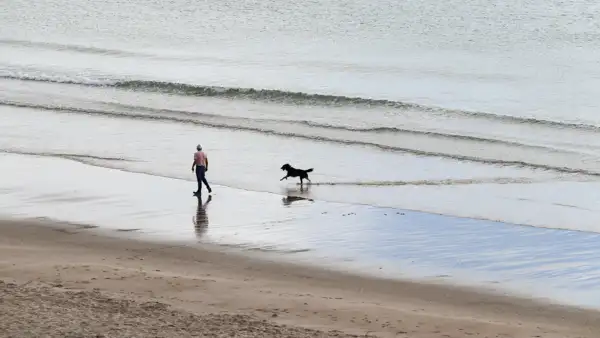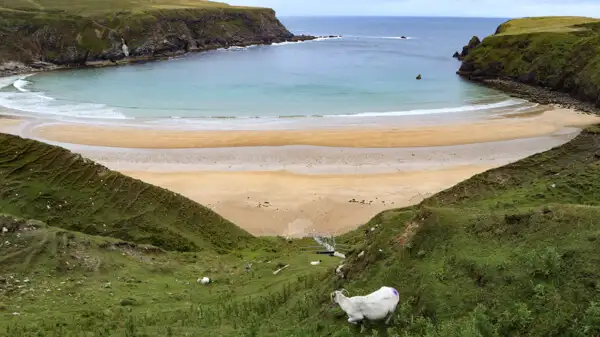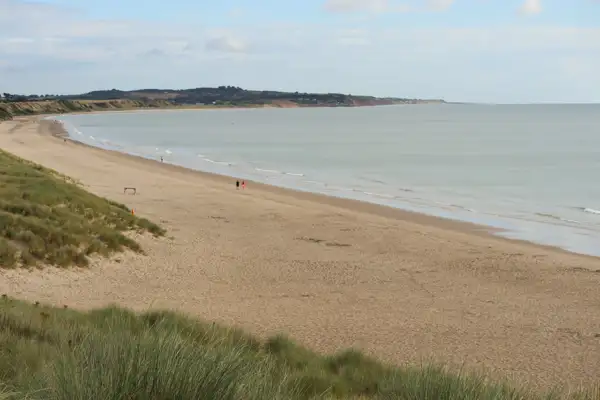“The health tip: walk your dog – whether you have one – or not!”.
In fact, most people find it easier to exercise if they have a dog and real dog lovers would never go hiking without their dog – why would they?
Page Contents (click line to jump the text)

Intro
We used to have two dogs that always accompanied us when we went hiking. Today, our daughter has a dog that accompanies her everywhere – and of course also for hiking (see cover picture).
And two days ago we (parents) also got another cute puppy, who is still much too small for hiking – but that will come…(update: no puppy anymore and very active…)
Where are we going hiking? In Ireland, of course!
We have our second home in Ireland and I have done a lot of hiking in the Wicklow Mountains and other places.
My article on the Wicklow Way can be found here.
Where are the Wicklow Mountains located? The beautiful mountain ridge begins in the south of Dublin and extends from there further south, always parallel to the coast.
In addition to the Wicklow Mountain National Park, Ireland offers many other fantastic hiking opportunities. Among the better known are the Wicklow Way, the Dingle Way, the Beara Way and the Kerry Way.
There are over 40 long-distance hiking trails lasting several days in Ireland, and many more opportunities for beautiful day hikes.
But how do you do it with a dog? We will go into this in more detail in this article:
Travelling to Ireland with a dog
Let’s start with the arrival: There are basically three possibilities:
#1 Arrival by car ferry via France
You can take your own car with the overnight ferry from Cherbourg in western France to Rosslare or Dublin. Thereby you stay overnight in a cabin (I can’t recommend the recliners).
Stenaline on the Stena Horizon, Cherbourg-Rosslare, (www.stenaline.de) has a cabin where you can take your dog, but it is often fully booked. Otherwise, the dogs sleep in a kennel adjacent to the deck. Each dog has a small cage there (with water and food), the door is secured with a number lock and the dog owners get the code and can access the kennel at any time. Walking on the deck is allowed (with a leash) at any time, you must of course remove and clean up any business that may occur (bring bags and paper). Update: Since 2023 a second ship operates on this line, the Stena Vision. It is significantly larger than the Stena Horizon and has several cabins where dogs can be taken!
Theoretically, the dog can also spend the night in the car. But you have no access to the car deck during the crossing! Breeders do this with ventilated vans, where the dogs can move around in the hold, but for private people with normal cars I don’t think this is a good solution, because most dogs are usually already “impressed” by the strange environment and the rocking and then the presence of the family is very reassuring.

At Irish Ferries (www.irishferries.com) there are two ships on the Cherbourg-Dublin route, the Ulysses and the WB Yeats. Both ships are also equipped with dog kennels.
The route via Cherbourg is ideal for those coming from southern Germany, or the Alpine region. The highways in the north of France cost about 70€ in tolls (each way), but are usually very easy to drive with little traffic. On the way you move within the EU area, which makes the formalities very fast and easy (Ireland is also in the EU).
#2 Arrival by car ferry via England
You can also enter Ireland via England. This can make sense if you are traveling from northern Germany, then Cherbourg is a big detour.
The advantage is: the crossings are comparatively short, even for your four-legged friend. Disadvantages: The traffic in southern and central England is quite comparable to German conurbations, so no fun. Also, England is no longer part of the EU and since the Brexit there are often long waiting times when entering England.
The fastest connection to England is the Eurotunnel. You drive your car into a train car, the train runs for about 40 minutes and then you drive out again – super easy!
The ferries from Calais to Dover take about 2.5 hours, and the dog usually stays in the car. check with your ferry company to see if you can take your dog on deck, but it’s not certain.
There are several ferry routes from England to Ireland, each taking about 3.5-4.5 hours:
Pembroke.Rosslare: Irish Ferries crossing (www.irishferries.de).
Fishguard-Rosslare: Crossing with Stenaline (www.stenaline.de)
Holyhead-Dublin: crossing with Irish Ferries or Stenaline.
In all cases and on all routes, it is recommended to register the pet/ dog in advance with the ferry company.
#3 Arrival by plane via Dublin
There are many cheap flights from Germany to Ireland. However, you should book long in advance, otherwise it won’t be that cheap. On the pages of the airlines you can find the following information:
Ryanair unfortunately does not take animals.
Lufthansa (www.lufthansa.de) allows dogs up to 8kg as “hand luggage” in the cabin, heavier dogs are taken with a transport box in the cargo hold. Since the flight only takes about 2 hours, this is the shortest possible travel time for your dog.
On Eurowings (www.eurowings.de), only dogs up to 8kg are allowed in the cabin.
Aer Lingus (www.aerlingus.com) takes dogs in a carrier in the hold. Booking is done through an agency called IAG Cargo (www.iagcargo.com).
If you choose another airline, you can usually find the travel regulations for pets via the search mask or in the FAQ (question-answer) part of the homepage.
In practice, however, the following surprise came up: When trying to book a flight with a dog from Germany to Ireland, it was not possible with KLM, Air France, or Lufthansa. Puzzlingly, all flights were fully booked far into the future.
The support at Lufthansa didn’t know what to do with it at first and had to inquire internally. After a while he came back with the information that supposedly no airline is allowed to take dogs to Ireland, which is supposed to be an old English law (prevention of rabies). However, this is not stated on the websites of the airlines.
So it is best to check in advance with the airline of your choice if they take dogs. In case of doubt, the car ride with ferry is otherwise the means of choice.

#4 Papers and vaccinations
You should take care of all the formalities for your trip with dog well in advance. Which are those, I tell you here:
Traveling with a dog within the EU
If you fly from Germany to Ireland, or travel from Germany via France to Ireland by car ferry, you are completely within the EU. There the travel regulations of the EU apply everywhere, which you can read on the homepage of the German Foreign Office (www.auswärtiges-amt.de) or on the page of the German Embassy in Dublin.
Accordingly, your dog needs an EU pet passport, a microchip and a rabies vaccination. The dog should be over three months old and should enter and leave the country with the same companion. The first vaccination must be at least 21 days old and repeat vaccinations must still be valid. In addition, the dog must be treated with a praziquantel-containing tapeworm medication 24-120 hours prior to entry. The veterinarian will help you with all of these requirements.
All papers and proofs will be checked before the ferry or at the airport and the chip will also be read.
Travel via the UK (no longer EU)
For all travel via England, Wales, Scotland or Northern Ireland you are leaving the EU. You can find the relevant entry information on the website of the English government (www.gov.uk/bring-pet-to-great-britain).
Again, your dog will need a pet passport, current rabies vaccinations, and current treatment for tapeworms.
You are also only allowed to travel via designated transit routes, which includes Calais-Dover and the ferries to Ireland.
Furthermore you have to fill in a declaration that you will not sell the dog within Great Britain. You can also find the form on the above mentioned page of the government.
#5 Further tips for the journey
Take care of the booking of the ferry or the flight very early. Also talk to your vet about all the necessary papers and vaccinations. You should do this several months before the trip, so that any outstanding vaccinations can be done in time.
If your dog spends the ferry crossing in the car, think in time about a sufficiently large transport box for the trunk. Of course, you must leave at least two windows open during the ferry trip, so that enough air gets in.
Before the ferry trip you should feed your dog only minimally, because even dogs can get sick when the ship is moving. There should always be enough water available, even in the box. For the possible “sewage” the box should be equipped with newspapers, cardboard or simply absorbent blankets that you can change afterwards.
If the trunk I big enough, you may be able to put these in the back seat or fold down the back seat to increase the space. Strapped into the back seat may work fine for short trips, but for longer trips, the dog should definitely have a more room to move and be comfortable.

Running low on other luggage? A roof box will help, then the hiking gear and other luggage can go in.
Remember to take plenty of water and the usual food. There is dog food on the road, but maybe not the same. Travel is not the ideal time to change food.
In addition to a leash and harness or collar, also think about a dog bed or blankets, a few toys and chews for the boring ride, and several drinking and food bowls.
If the trip is by overnight ferry, also think about several bags and cleaning wipes to clean up occasional “hops” on deck. For yourself, take warm and windproof clothing on board so you can spend as much time as possible with your four-legged friend on deck.
Also for the flight you will need a carrier, leash and collar, some food, food water bowl, pad and cleaning supplies for afterwards. There are prescribed sizes for the transport box depending on the size of the dog – choose one size larger!
Transport with dog in Ireland – Own car, public transport, rental car
If you arrive with your own car, the further transport is settled. The situation is different if you land at Dublin Airport. What happens now?
The easiest way is to book a rental car and leave the transport box and your luggage in it – done!
But what about public transportation?
Small dogs are usually allowed on Dublin buses if they are on a leash and on the owner’s lap for the entire ride.
On Bus Eireann (www.buseitreann.ie), which travels throughout the country, only guide dogs and assistance dogs with identification are allowed. However, this can also differ depending on the bus company. Therefore, I would always recommend to check the homepage of the respective planned bus company in advance.

On the train (www.irishrail.ie), only guide and assistance dogs are allowed in the compartment. Other dogs must travel in the Guards Van, which is not a passenger compartment and is not available in every train. There only helps to inform in advance exactly and/or call the service.
On the Dart, Dublin’s local train, dogs are allowed as long as they are on a leash.
Overall, however, the issue of public transport with dogs in Ireland is troublesome, so that the own car or rental car are certainly the better option.
How and where can you hike with a dog in Ireland?
Dogs are allowed on almost all hiking trails in Ireland, but often only on a leash. This is partly because of nature reserves, or because the forestry farmers do not want poaching dogs for understandable reasons. In a country with more sheep than inhabitants and millions of little lambs in spring, this is understandable.
Still, you see dogs running off leash all the time – if your dog listens reliably and you’re alone on the mountain, there’s probably nothing wrong with that. If everyone behaves well, a lot is also tolerated. Near sheep pastures or other animals, to spare the farmers’ nerves, I would always put the dog on a leash, especially if it’s a larger dog.
This is more important than you might think, because unlike in Germany, not everyone is allowed to use every dirt road or forest path – private land in Ireland is also private land and may only be entered if the owner allows it. This also applies to private sections of designated hiking trails!
You can find some of the options in my blog – just look around further in the “On Foot” section in the menu of this site.

You can also find a very good overview of over 40 long-distance hiking trails in Ireland on Tough Soles’ blog (www.toughsoles.ie). Ellie and Carl have actually hiked all 40 long-distance trails and have written very readable reports about them. They have also created nice hiking maps for download.
Of course you can also walk parts of the long distance trails as day trails and there are many more local trails in many regions. Ireland is organized by counties. If you know your county, you can find a lot of information about the local hiking possibilities on the respective tourism site, for Wicklow for example there is the site www.visitwicklow.ie.
What to consider when hiking with dog
Bring not only a short leash, but also a long one! An extendable flexy leash or a tow line can be very helpful. A good chest harness can be more comfortable for the dog than a collar, this is especially true for small dogs.
Think about having several water bottles and collapsible bowls for water and food.
It’s also a good thing on hiking trails to clean up the dog’s mess – bring bags.
The terrain can be rocky and he dog may run into sore paws – a small doggy first aid kit and disinfectant may be included when hiking.
A light blanket to lay down during breaks in hiking is also useful, it can be wet and cold.

Staying overnight with a dog in Ireland
Here you should also inform yourself in good time before starting your trip and choose your accommodation carefully.
While in most hotels and B&Bs small dogs may be taken to the room, this is less natural for larger dogs.
Check the pages of your desired accommodation before booking and call ahead if in doubt. The Irish like to talk on the phone and you can discuss almost everything. Often it goes then nevertheless, even if it does not go actually…
We ourselves offer guest rooms on the Wicklow Way near Tinahely, as well as pick-up and drop-off services. Walkers on the Wicklow Way can stay with us for one to three nights, because we can pick them up from the previous station and drop them off at the next station.
As we have dogs ourselves, dogs are allowed with us by arrangement. You can find more information on our website, www.the-view-accommodation.ie. You can also stay with us and do day hikes in the Wicklow Mountains – just ask, we are happy to help!
By the way, Airbnb and Booking.com apps are widely used in Ireland. You can always use them to find suitable accommodations – and then call to discuss the dog issue.
Conclusion
If you prefer to hike and experience Ireland with your dog – you can!
Ireland has gorgeous landscapes and stunning coastlines – so what are you waiting for?
There are a large number of great hiking trails in Ireland and getting there is also possible with a dog. Ideally, you should take your own car, or fly and take a rental car.
Of course, you should find out in advance about the formalities of travel and entry, as well as dog-friendly accommodation.
But with a little preparation everything is not so complicated in the end. I hope I could help you a little bit – feel free to read some more of my articles about hiking in Ireland – and then see you on the Emerald Isle!
More interesting articles for you
HIKING THE WICKLOW WAY – ALL INFO FOR YOUR VACATION PLANNING
THE MOST BEAUTIFUL HIKES IN IRELAND’S SOUTHEAST
THE ULTIMATE PACKING LIST FOR MULTI-DAY HIKES IN IRELAND
THE MOST BEAUTIFUL HIKES IN THE SOUTHWEST OF IRELAND
Photo credits title image: Josephine Gertberg (my daughter)